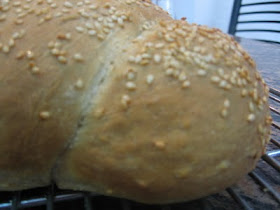Well maybe I'm exaggerating, but just a little. My problem is that I am not a patient person when it comes to baking bread. No, that's not entirely true either. If you are going to bake bread, you have to be patient. Period. What I mean is, that when I get an idea, or hear about a new technique, or just plain 'get bitten by the bug', then I have to do it and right away. I mean now. I am still burning up trying to figure this one out. Really. One of the latest 'rages' sweeping the the bread-baking world is no-knead bread. This is a method (a shortcut really) to make an artisan-style loaf without kneading the dough!! I know! Huh? So I had to try it. I mean, how could I not try this? The problem was that it needs to 'bake' (cook really) inside a superheated cast-iron pot. Which I don't have. So... I said to myself, maybe I can use a large soup pot I have, protect the handles and it will be fine. And I melted the handle on the cover. I mean it's totally distorted, despite my efforts to reshape it through the aluminum foil while still hot. I don't get it!! Anyway, in the end, I baked the bread in the oven, conventionally but with no kneading, on a baking stone. It was delicious with a tough chewy crust and fairly open crumb. The seeds (sunflower and ground flax seeds) added great nutritional value and, of course, the extra crunch we all like. Now all I need is to find a cast-iron pot with a lid! (The one I saw at a restaurant supply store yesterday sold for about $185!!! So I'm still looking.
Here's What You'll Need:
3 cups of flour (bread flour is recommended)1 1/4 teaspoons salt
1/4 teaspoon instant yeast
1 1/3 cups of cool water (approximate amount)
1/4 cup sunflower seeds
1/4 cup ground flax seeds
Here's What You'll Need To Do:
1. Mix together the flour, salt and yeast. Pour in the water and stir with a wooden spoon for about half a minute. The mixture should be sticky. If it is not sticky enough, add more water until it is.2. Cover your bread dough and let it sit at room temperature until it is twice the size and covered with bubbles. This can take 12 to 18 hours.
3. When the dough is ready, using a rubber spatula or similar tool, push the dough towards the center of the bowl. The dough will be sticky and will pull out in long strands. This is how it should be so avoid the temptation to add flour, other than lightly flouring your hands. Do what you can to tuck in the edges of the dough and to form a round shape.
4. Turn your dough out onto a piece of parchment paper or waxed paper. Put the seam side down and cover the dough with a towel. Be sure the dough is not sitting in a draft. Allow it to sit again until it doubles in size. This could take between one and two hours.
5. Now at this stage, you're supposed to preheat the oven to 500F (260C). Place the iron pot with the lid in the oven to heat thoroughly for half an hour after it reaches the temperature. Then, carefully, remove the pot from the oven open the lid, and slide the risen dough, smooth side up, into the pot (you will hear it sizzle) cover it and place it back in the oven. Lower the temperature to 450F (220C) and bake for about 40 minutes. Remove it and cool it on a rack. It will be very dark and gnarly but also very chewy and delicious. Yum
6. However, as I said, instead I ruined my soup pot since I have no patience. So...
I placed the dough on the baking stone, shaped like a boule, and baked conventionally, at 450F (220C) for 40 minutes. You can see the results for yourself.!













































